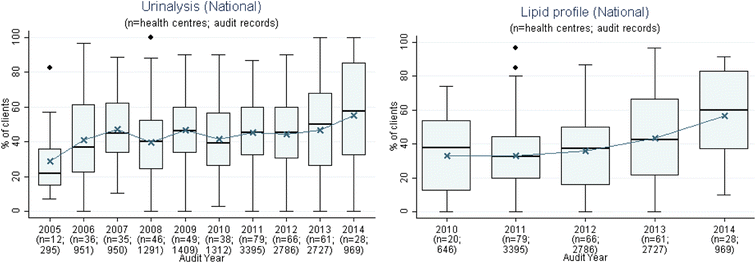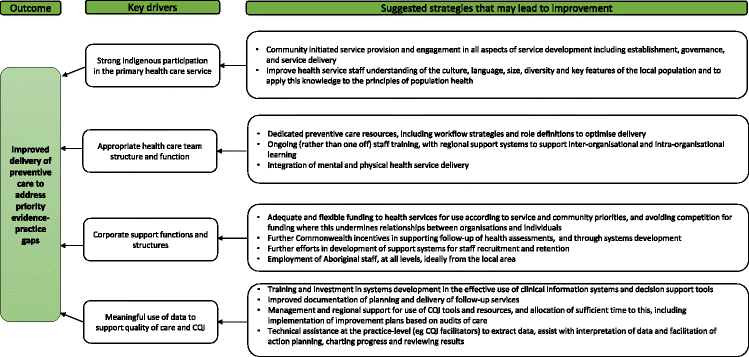Improving preventive health care in Aboriginal and Torres Strait Islander primary care settings
- PMID: 28705223
- PMCID: PMC5512740
- DOI: 10.1186/s12992-017-0267-z
Improving preventive health care in Aboriginal and Torres Strait Islander primary care settings
Abstract
Background: Like other colonised populations, Indigenous Australians experience poorer health outcomes than non-Indigenous Australians. Preventable chronic disease is the largest contributor to the health differential between Indigenous and non-Indigenous Australians, but recommended best-practice preventive care is not consistently provided to Indigenous Australians. Significant improvement in health care delivery could be achieved through identifying and minimising evidence-practice gaps. Our objective was to use clinical audit data to create a framework of the priority evidence-practice gaps, strategies to address them, and drivers to support these strategies in the delivery of recommended preventive care.
Methods: De-identified preventive health clinical audit data from 137 primary health care (PHC) centres in five jurisdictions were analysed (n = 17,108 audited records of well adults with no documented major chronic disease; 367 system assessments; 2005-2014), together with stakeholder survey data relating to interpretation of these data, using a mixed-methods approach (n = 152 responses collated in 2015-16). Stakeholders surveyed included clinicians, managers, policy officers, continuous quality improvement (CQI) facilitators and academics. Priority evidence-practice gaps and associated barriers, enablers and strategies to address the gaps were identified and reported back through two-stages of consultation. Further analysis and interpretation of these data were used to develop a framework of strategies and drivers for health service improvement.
Results: Stakeholder identified priorities were: following-up abnormal test results; completing cardiovascular risk assessments; timely recording of results; recording enquiries about living conditions, family relationships and substance use; providing support for clients identified with emotional wellbeing risk; enhancing systems to enable team function and continuity of care. Drivers identified for improving care in these areas included: strong Indigenous participation in the PHC service; appropriate team structure and function to support preventive care; meaningful use of data to support quality of care and CQI; and corporate support functions and structures.
Conclusion: The framework should be useful for guiding development and implementation of barrier-driven, tailored interventions for primary health care service delivery and policy contexts, and for guiding further research. While specific strategies to improve the quality of preventive care need to be tailored to local context, these findings reinforce the requirement for multi-level action across the system. The framework and findings may be useful for similar purposes in other parts of the world, with appropriate attention to context in different locations.
Keywords: Aboriginal and Torres Strait Islander health; Preventive health care; Primary health care.
Figures








References
-
- Australian Institute of Health and Welfare. The health and welfare of Australia's Aboriginal and Torres Strait Islander peoples 2015. Cat. no. IHW 147 ed. Canberra: AIHW; 2015. http://www.aihw.gov.au/publication-detail/?id=60129550168. Accessed 23 June 2017.
-
- Australian Institute of Health and Welfare. Access to Health and Services for Aboriginal and Torres Strait Islander people. Canberra: AIHW; 2011. http://www.aihw.gov.au/publication-detail/?id=10737418966. Accessed 23 June 2017.
-
- Dwyer J, O'Donnell K, Willis E, Kelly J. Equitable care for indigenous people: Every health service can do it. Asia Pac J Health Manag. 2016;11(3):11.
-
- Bailie J, Schierhout G, Laycock A, Kelaher M, Percival N, O'Donoghue L, et al. Determinants of access to chronic illness care: a mixed-methods evaluation of a national multifaceted chronic disease package for Indigenous Australians. BMJ Open. 2015;5(11):e008103. doi: 10.1136/bmjopen-2015-008103. - DOI - PMC - PubMed
MeSH terms
LinkOut - more resources
Full Text Sources
Other Literature Sources

